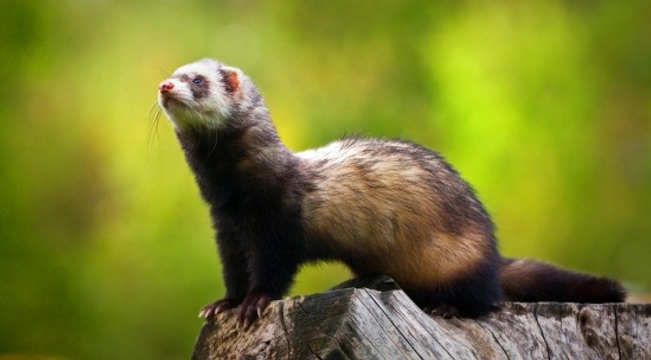
The Differences Between a European Polecat and a Domestic Ferret
Genetically, ferrets and polecats are remarkably similar and both can be found in many areas throughout the UK. Ferrets, Mustelo furo can be found in the wild simply because they have either escaped from captivity or have been lost by their owners. They typically live solitary lives or sometimes in feral populations. However, the polecat, Mustela putorius, boasts being the ferret's ancestor although how and when ferrets were first kept in captivity and domesticated, still remains a bit of a mystery. Another interesting fact is that the polecat and ferret are able to interbreed producing fertile young.
Very Hard to Tell Them Apart
Because of their remarkable likeness and ancestry, it can be quite hard to tell a ferret from a polecat and this is especially true when spotted in the wild. The only real way of telling them apart is to examine them closely taking note of their coat colours and the shape and size of their skulls although this too can be deceiving as there tends to be a lot of overlap when it comes to skull size between the two.
With this said, it is generally thought polecats boast larger heads than ferrets and this applies to both males and females of the two species. The one thing that is generally accepted by all, is that ferrets boast more coat colour variations that polecats. However, confusion starts as they can also have coats which are just as dark as that of a polecat so in some cases, it can be hard to distinguish whether the animal is indeed a ferret or a polecat.
Ferret Hybrids
As previously mentioned ferrets and polecats can interbreed and they produce fertile offspring which can muddy the waters even further when it comes to telling them apart. The offspring of the two are referred to as hybrids and can take on the traits and characteristics of both a ferret and a polecats. When bred in captivity, a ferret crossed with a polecat is often called polecat-ferret"".
Both ferrets and polecats will moult in the spring and then again in the autumn and both boast having darker and shorter coats during the summer months than they normally have in the winter time. Another striking thing about both breeds is that their undercoats show through on their flanks and backs which tends to give their pellage a lighter appearance and the same can be said of their frontal bands and cheek patches – the one distinguishing difference is that polecats boast a more pronounced facial mask.
What is Erythrism?
There exists a reddish colour mutation known as erythrism which occurs occasionally in polecats that have been seen in Oxfordshire and Wales although it is thought this mutation could in fact, occur anywhere within the UK. Whilst ferrets can boast colour variations which range anything from creamy white to a very dark brown similar to the coat colour of a polecat. Polecats on the other hand have darker coats with the mutation in colour being present in some of them – hence erythrism.
Where You Will Find Polecats
These days, you'll find polecats throughout the Midlands and all over Wales with a few isolated populations found in Scotland since they were reintroduced back in the seventies. They can also be found in the north-west of England and in other regions of the land as polecat populations continually expand into new areas of the country.
A Quick Guide to the Differences
- Domestic ferrets tend to be smaller and they have a delicate, fragile bone structure than polecats.
- They also tend to be lighter in colour with their masks not reaching the typical tinted neck band.
- A polecat on the other hand has a much more pronounced mask and a rounder face than that of a ferret.
- Another difference is that the back of polecat's ears are dark rather than light as with a ferret.
- Polecats do tend to have much stronger jaws than a domestic ferret which could have something to do with the way have evolved and not having to chase down their prey for food. For this same reason, polecats tend to be more muscular.
- The most marked difference between the two has nothing to do with their looks but rather their characters with polecats preferring to lead solitary lives only meeting up with another polecat when it's time to mate.
- Ferrets are more gregarious by nature and therefore they tend to love company whether human or other ferrets.
""



